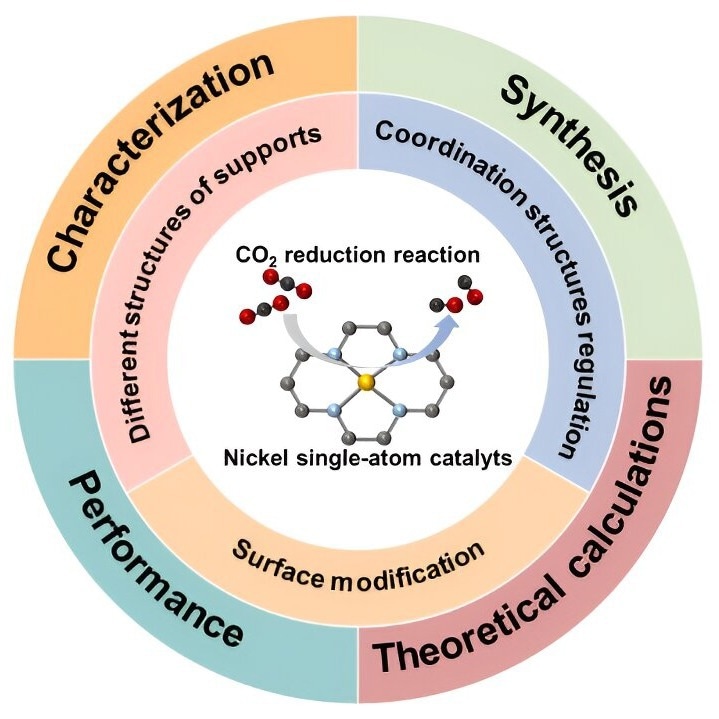Carbon dioxide (CO2) reduction by electrocatalysis is thought to be a useful tactic for reducing greenhouse gas emissions and the energy problem. Because it is an essential feedstock for the Fischer-Tropsch process, which can produce valuable long-chain hydrocarbons, carbon dioxide (CO2) is thought to have the highest market value among the numerous reduction products.

Strategies to enhance the performance of nickel single-atom catalysts for the electroreduction of CO2 to CO. Image Credit: Yuhang Li, Chunzhong Li, East China University of Science and Technology, China
Increasing the reaction activity and product selectivity are still major issues in the carbon dioxide reduction reaction (CO2RR) due to its complicated intermediates and various proton-coupled electron transfer mechanisms.
The benefits of single-atom catalysts (SACs) include outstanding catalytic activity, high atom usage, and variable coordination structure. Furthermore, nickel metal's unique electrical structure makes it more prone to losing electrons, resulting in vacant outermost d-orbitals and showing strong activity and selectivity for CO2RR to produce CO.
A group of experts have provided an overview of the significant advancements made in Ni SACs in recent years. The study was published in the journal Industrial Chemistry & Materials.
Designing novel catalysts to improve the activity and selectivity of CO2RR is crucial for conquering the problem of energy crisis and environmental pollution. In this mini-review, we introduced three strategies used to improve the catalytic performance of Ni SACs, including different structures of supports, coordination structure regulation, and surface modification. In the end, we also summarized the existing challenges of Ni SACs and provided an outlook on future development in this field.
Yuhang Li, Professor, East China University of Science and Technology
SACs achieve remarkable electronic structure, strong metal-support interactions, low-coordinated metal atoms, and maximal atom utilization simultaneously by shrinking the active sites to the atomic scale. Therefore, the use of SACs in CO2RR could reduce the expense associated with product separation and efficiently regulate product distribution.
Li stated, “Some research based on crystal-field theory has indicated that the d-orbital electronic configurations of central metals are significant to the selectivity and activity of CO2RR.”
In the case of nickel as the central metal atom, it is more likely to form the vacant outermost d-orbital to facilitate the electron transfer between the C atom of CO2 and the Ni atom. Therefore, the absorbed CO2 molecules can be efficiently activated. Ni SACs can also minimize the reaction potential of CO2-CO conversion, which is of great importance to enhance the selectivity towards CO.
Yuhang Li, Professor, East China University of Science and Technology
Li said, “Ni SACs have achieved continuous progress in recent years. From a microscopic point of view, the design strategies include choosing different substrates, regulating the coordination structure, and modifying the catalyst surface. The electronic structure of the active center is the most crucial factor affecting catalytic performance.”
Ni SACs have a ton of untapped potential for use in upcoming projects and ideas. Ni SAC performance is further improved by precise microstructure manipulation, which produces more active sites.
Expanding the uses of Ni SACs and facilitating their large-scale commercialization in the future can be achieved by electrolytic cell optimization and the creation of other electrolyte types.
Furthermore, researchers believe that expanding the number of in-situ methods to obtain a more profound understanding of the connection between material structure and characteristics can offer important direction for creating higher-value Ni SACs.
In this mini-review, our main goal is to provide readers with the current research progress in Ni SACs in CO2RR and to show our insights into the design and application of single-atom catalysts.
Yuhang Li, Professor, East China University of Science and Technology
The research team consisted Ziyan Yang, Rongzhen Chen, Ling Zhang, Yuhang Li, and Chunzhong Li from East China University of Science and Technology.
Journal Reference
Yang, Z., et.al., (2024) Recent progress in nickel single-atom catalysts for the electroreduction of CO2 to CO. Industrial Chemistry & Materials. doi.org/10.1039/D3IM00109A.